The Razer Edge Review
by Vivek Gowri on March 28, 2013 11:00 AM EST- Posted in
- Tablets
- Mobile
- Razer
- Razer Edge
Performance
Now for the good parts. We’re actually pretty familiar with the computing platform behind the Edge. The ultra-low voltage IVB parts are commonly found in ultrabooks and are some of the AT mobile team’s favorite mobile processors right now. I’m not the only one, Dustin just rhapsodized about the ULV Core i5s in his review of the updated Dell XPS 13 last week. The usable performance and reasonable power draw on offer are just that fantastic, and these CPUs really represent the sweet spot of the market right now. I’m not sure that the additional CPU headroom of the i7s is really necessary or worth the additional cost; the 100-200MHz clock speed bumps are pretty incremental. The only really compelling thing about the i7 SKUs is their ability to hit 3.0-3.1GHz on Turbo, a solid 400MHz higher than the corresponding i5 parts.
The other thing is that I’m seeing a lot of cases where there will be two SKUs on offer – one with an i5, 4GB RAM, and a 64GB/128GB SSD, and then a high end one that offers spec bumps across the board – i7, 8GB, and 128GB/256GB. We’re moving away from the early 2000s Dell/HP/Gateway-era of pick your component computing, so the decision between i5 and i7 chips might actually be hinge on the rest of the package, as is the case with the Edge.
Anyways, that’s diverging a bit. We’re very familiar with both of the CPUs used by the Edge from various ultrabooks; in particular, the i5-3317U is the heart of my trusty ASUS Zenbook Prime and I just recently looked at the i7-3517U in my review of the Vizio CT15. The i7-3517U has a base clock speed of 1.9GHz and a max turbo of 3.0GHz, along with HD 4000 onboard graphics (350MHz base clock, 1.15GHz max). It performs roughly where we’d expect, and I’d also like to highlight the relative lack of differences between the i5 and i7 ULV SKUs here.
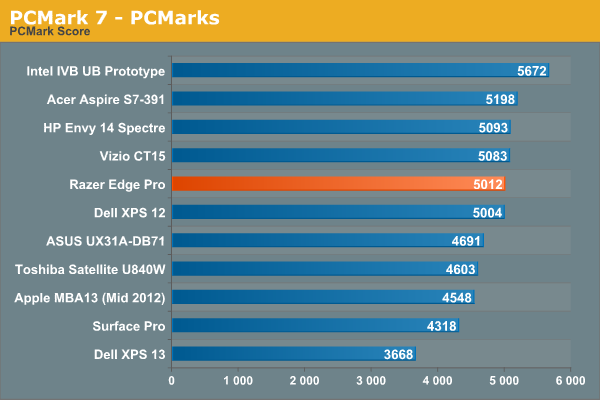
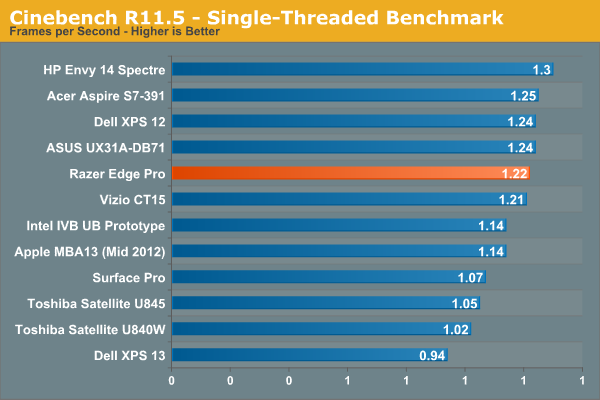
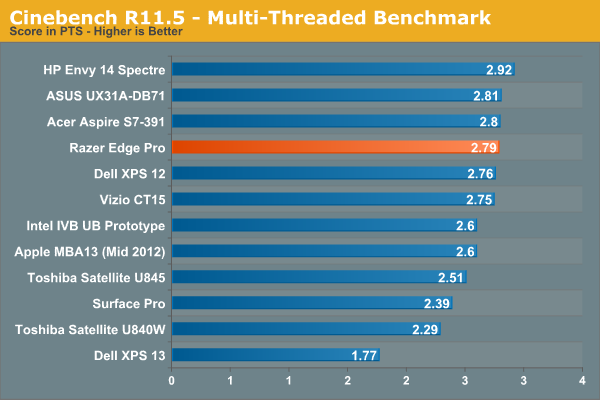
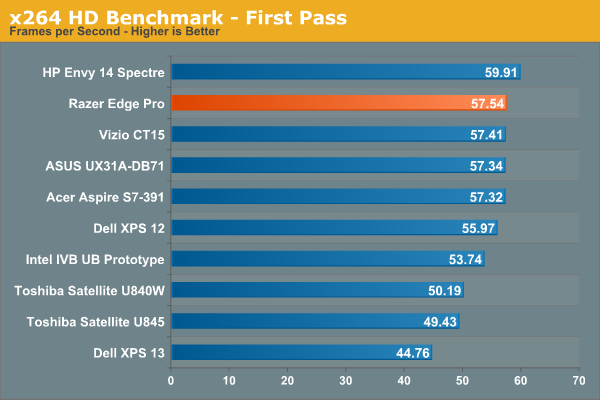
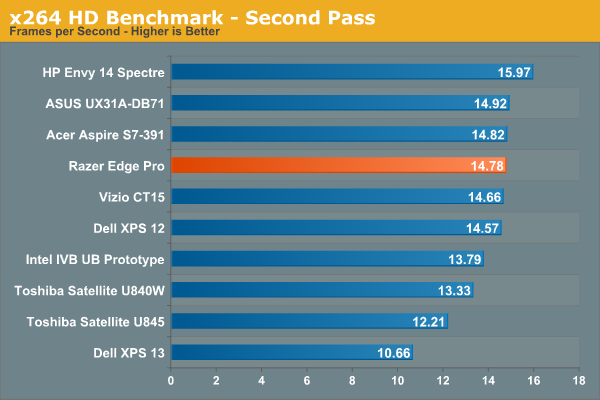

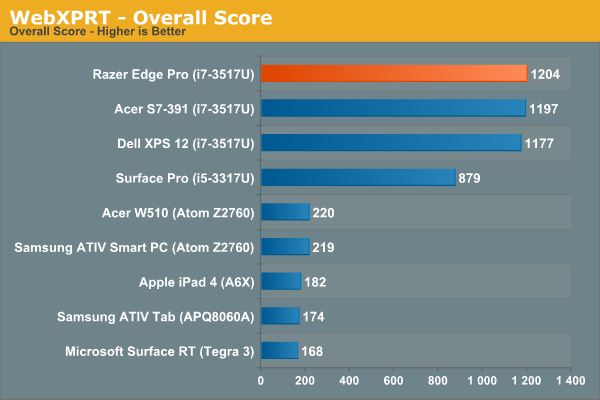
Graphics Performance
Nvidia’s mobile GPU heirarchy can get very, very convoluted, particularly at the low end, with a mix of new, old, and gap-bridging parts all under the same name. As such, there are many variants of GT 640M and GT 640M LE, with a mix of SKUs spanning the 28nm Kepler, 40nm Fermi, and 28nm die-shrunken Fermi cores. An interesting and related side-note: a few days ago, Anand asked the mobile team if we had seen any Kepler-based GT 630M notebooks. It took a bit of searching, but eventually it was determined that none of the GT 630M SKUs are actually Kepler based, only 28nm and 40nm variants of the Fermi core. When the lineups are so jumbled that even we can’t keep track of them, there’s something wrong. Why are some GT 640Ms so slow, while others are nearly equal to the DDR3 GT 650M? Why are there still 40nm GeForce 600M parts? I wish Nvidia could simplify and streamline their mobile GPU lineup, it’d make our lives easier as well as being a lot more transparent for consumers.
The GT 640M LE in the Edge is thankfully a Kepler part, so a 28nm GK107 core with 384 cores, 16 ROPs, and 32 TMUs, just like all Keplers from the GTX 660M on down. This is the absolute bottom of the range, so it has the slowest memory configuration (900MHz DDR3) and a 500MHz core clock, with boost up to 570MHz. The next big hardware jump comes with GDDR5 VRAM in the GT 650M, and a combination of clock speeds and GPU boost make up the differences between SKUs.
The 1366x768 panel comes into play here – Kepler, even at 500MHz, is more than capable of pushing 768p displays at high settings in modern games. High quality textures really start to tax the slower memory in the low-end Kepler cards as you increase resolution, so even with higher clock speeds, 1080p gaming will be non-ideal at best and downright bad at worst. Don’t expect much to be playable, as even the DDR3 variant of the GT 650M basically failed the 1080p portion of our gaming tests. The GDDR5 GT 650M and the GTX 660M (which comes in GDDR5 form only) do better here, but there’s a pretty substantial gap between those two chips and the rest of the GK107 mobile parts at 1080p.
We haven’t yet finalized our 2013 Gaming test suite, so I just ran our 2012 test suite. I did almost all of my testing on the road, sans access to 1080p displays, so I only have 1366x768 gaming results (that’s our value gaming suite, which runs medium detail settings at 768p). I also ran at high detail settings, to see what kind of differences there would be. Once our new suite is finalized, I’ll update with results at 1600x900 and 1080p.
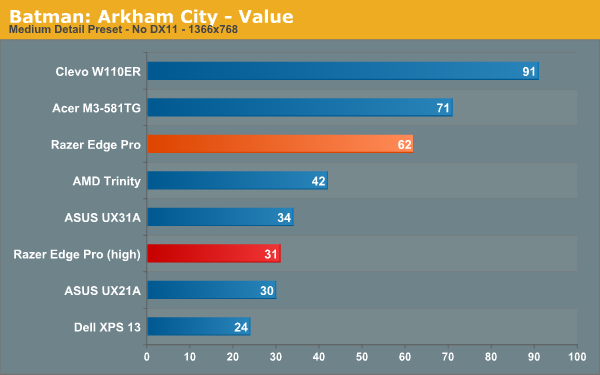
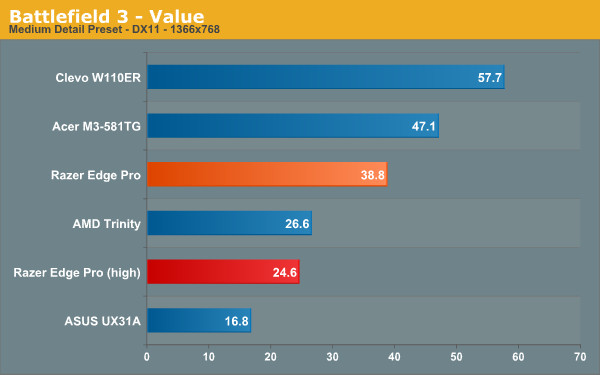
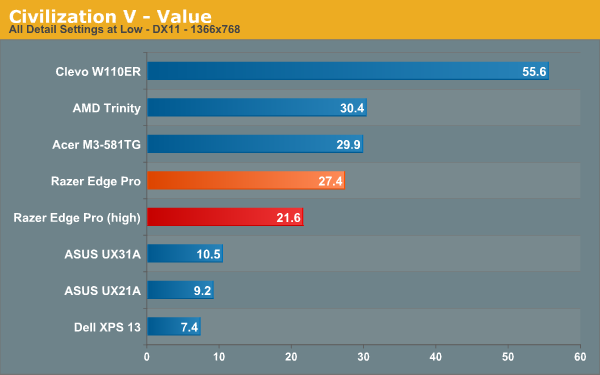
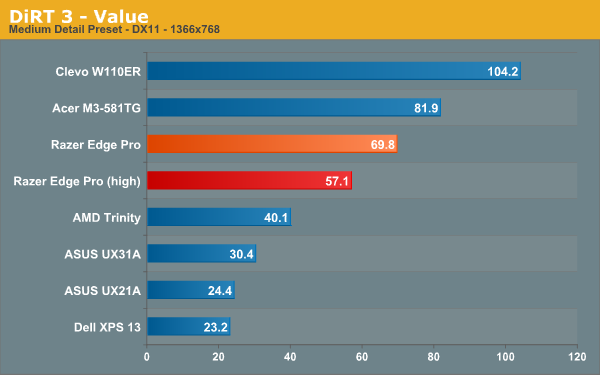

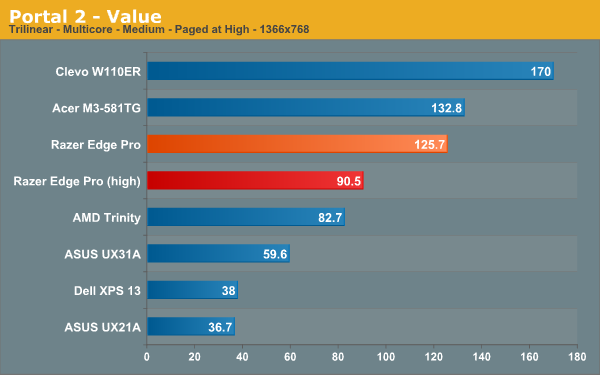
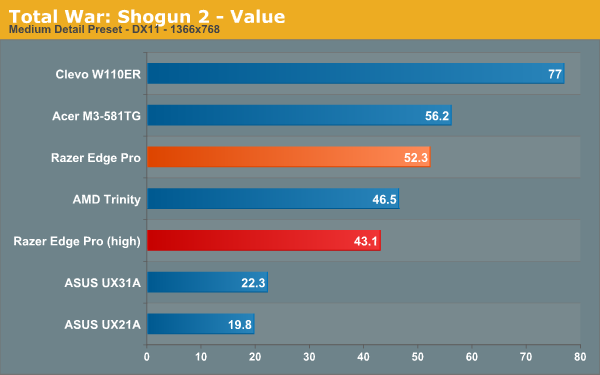
The Edge does pretty well, honestly – Kepler is a great mobile GPU, even clocked so low. At high settings, almost everything was playable, except for Battlefield 3 and Civ 5. I think Civ 5 is CPU limited on the Edge, while BF3 is one of the more strenuous games we test, so both of those were expected. Lower the settings to medium, and pretty much everything is playable.
The higher clock speeds of the GT 650M (DDR3) in the Clevo W110ER really make themselves felt, with substantially better gaming performance than the Edge throughout our benchmark suite. For a comparison with Surface Pro and the other IVB tablets, look at the ASUS Zenbook Primes - the UX31A with the 1.15GHz HD 4000 (i7-3517U) and the UX21A with the same HD 4000 clocked at 1.05GHz (i5-3317U). There's a small performance delta between the two due to the maximum frequency difference, but either way, HD 4000 seriously struggles to be playable in most of our benchmarks unless you lower either the resolution or detail settings. Again, Kepler at 500MHz is still a pretty capable card at 1366x768, so concern over frame rates is probably a moot one unless you’re gaming on an external display.










89 Comments
View All Comments
jeffkro - Friday, March 29, 2013 - link
I heard an interview with a game developer who started in PC gaming, forget which one. He said they pushed for the switch from PC to consules, tragic. Now he said their push is going to be from consules to mobile devices, even worse. These are sad days for PC gamers, and each step down to lower end hardware has cut the potential of gaming.perry1mm - Saturday, March 30, 2013 - link
I think a lot of people miss the point and just overlook the potential uses this offers for people that might travel a few weeks or even months out of the year and are on the go a lot.For work I spend a couple weeks in a hotel a year, travel to see family a week or two, and spend a few weekends away here or there, not to mention just driving around or spending time out and about sitting down someplace for an hour or two.
There is no way I'd haul around my gaming desktop, this is great for on the couch average use, docking on-the-go, and gaming when plugged while traveling.
BUT, I ended up getting the Sony Vaio Duo 11 two months ago and it does all of this stuff, has a backlit keyboard attached already, I got the extended battery on sale, and total I paid $1450 for mine with a promo + $100 credit since I got the Sony Card, plus 8500 points ($85 more dollars of Sony Rewards). So out-the-door around $1300 with the newer i7 3537u, 8GB RAM, 256GB SSD, and the HD 4000 has played 90% of the games at full resolution (1080p).
Not to mention the HDMI built in, VGA out, SD slot, 2 USB 3.0 slots, and numerous other features that make it much more handy in a laptop functionality (gaming) a lot with still being portable for touch use in tablet mode.
For the people that rip on these products as being overpriced...no. When an ARM tablet can cost $500-800 and an ultrabook $1000+, paying $200-500 more for this with the hardware you're getting, storage/SSD, and accessibility, it is NOT really that expensive.
Now if all you do is sit at home and play games for a few minutes on your phone when on-the-go, or you don't care about space and lugging around a large laptop...then maybe this isn't for you. But both the Edge and Vaio Duo for me were great fits, I just happened to be perfectly happy with the Duo as to not need the Edge.
Netscorer - Saturday, March 30, 2013 - link
Weight and battery life are killers for this product. Price is an issue but there are people willing to pay for the mobility and they would not mind paying extra for exclusivity too. But once you consider that you always (ALWAYS!) need to brace this tablet against something (be it a lap on a train or table at the coffee shop) and that even then you can get at most 2 hours on a freshly charged batteries, the appeal of this hybrid goes way down and frankly, you can do the same on a laptop with a good trackpad, costing much less and having more versatility in other functions. By the way, I was surprised that Vivek never mentioned how absence of the physical keyboard affected using this device. Microsoft did a piss poor job with the virtual keyboard that blocks 2/3 of the screen every time you bring it up and when something like this happens as you prepare to game, it would be a major nuisance.MobiusStrip - Monday, April 1, 2013 - link
Look at that idiotic glossy screen.Death666Angel - Monday, April 1, 2013 - link
It's definitely an interesting product. I don't need a portable gaming machine, so this isn't for me. But even if it were: no display output and the display resolution kill it for me. You may justify the resolution, but it is still not acceptable for me. I'd rather have smaller pixels so that non-native resolutions look better as well. This is a compromise I'm not willing to put up with (and yes, I know that higher resolution would also mean more power draw from the display at same brightness). Also, 11.6" would have been a better display size in my opinion, could have upped the battery package or reduced the thickness. And I personally still don't play FPS games with a gamepad (or many other types for that matter) so for many games I'd need the dock and a keyboard/mouse. All in all, I think I'm better off with sticking with my Ativ Pro for the few games I want to play when I'm on holidays. :DAs for the review: Well done. But I'd really like a comment on whether or not this tablet supports Optimus and the corresponding battery life. :)
IceStorm - Tuesday, April 2, 2013 - link
As an Edge Pro owner, I agree with what has been written in the review. I've been busy installing and playing games since it arrived yesterday. It is fun.I have tried the Surface Pro. The lower resolution of the Edge is not an issue. If anything, it makes it easier to select things when at the traditional desktop. The screen is quite nice, and I have a retina iPad and a Kindle Fire HD for comparison.
This is an early adopter product. It is not for everyone. Just like the first Blade, if you balk at the price it isn't for you. The Razer store sold out of the initial production run of the 256GB Edge Pro in less than five hours. There is a market for it.
seapeople - Sunday, April 7, 2013 - link
I can picture the scene now outside the Razer store. A bunch of happy gamers walking out to their Corolla's, stumbling over the curb as they are locked into an intense game of Half Life, while dozens of well dressed men in suits shake there head and sneer as they lament how much money these gamers are wasting on this platform. The men in suits then jump into their Ferrari 328 GTS's and cruise off into the sunset, waiting in tempered melancholy for the day when they, too, will have the means to afford a handheld gaming unit that will bring joy to their lives.0 adrian 0 - Wednesday, April 3, 2013 - link
.MajinBlayze - Tuesday, December 3, 2013 - link
In your review regarding the downgrade from the pro version:"You lose the 1080p display and Wacom digitizer"
according to the support page here: http://www.razersupport.com/gaming-systems/razer-e... "The Razer Edge is not Wacom or pressure sensitive compatible"